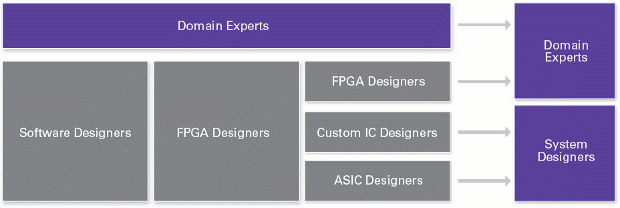National Instruments has recently published a report entitled “Embedded Systems Outlook 2012 – Key Technologies and Methodologies Impacting the Embedded Systems Market” which lists technology and business trends for the development of embedded systems.
Here are the key findings:
- Technologies & Architectures:
- Embedded Platforms
Technology providers are developing components, modules, or even complete embedded platforms (software + hardware) with higher levels of integration and increased functionality to speed up time to market. System-on-Chip (SoC) and System-on-Module (SoM) benefit from this trend and some also embed a FPGA. - Reconfigurable Computing
Previously, designers chose between low-cost microcontroller or high performance CPU based on the expected performance needs of the embedded system. As cost decreases and performance increases, low cost devices such as control and monitoring systems now often come with more features thanks to the use of programmable logic. This type of flexibility can be achieved by adding an FPGA to the MCU / MPU in the embedded systems platform. - Mobile Devices and the Cloud
Design teams are taking advantage of new mobile devices and cloud technologies within embedded systems. NI shows the smartphone industry has dramatically changed between 2009, where Symbian phones prevailed and 2011, where Android devices had the largest market share, but the market is still very much fragmented and will continue to be in the years ahead. NI then talks about the cloud, the security issues that arises for embedded systems and the need to support multiple platforms with technologies such as HTML5.
- Embedded Platforms
- Business Strategies and Processes
- Innovating with smaller teams
Small teams are emerging around the world and are proving that innovation can happen just as fast, if not faster, in smaller design teams. This is mainly possible thanks to off-the-shelf solutions and tools such as NI LabVIEW instead of having to design those in-house. Those tools allow companies to move to smaller teams as shown in the diagram below. - Future proofing through software
Many embedded developers have adopted a software-first philosophy for upgrading products over time in order to match customer expectations for data visibility, connectivity, and performance. For most embedded systems, the expectations for longevity of design and service life remain well over a decade. NI shows 2 future-proof examples: Smart Grid and Software Defined Radio (SDR). The company also explains how to future-proof your design by selecting software-definable hardware (e.g. DSP / FPGA instead of ASiC) , allowing update over the air (OTA) or via USB stick, and by selecting the right toolchain.
- Innovating with smaller teams

Jean-Luc started CNX Software in 2010 as a part-time endeavor, before quitting his job as a software engineering manager, and starting to write daily news, and reviews full time later in 2011.
Support CNX Software! Donate via cryptocurrencies, become a Patron on Patreon, or purchase goods on Amazon or Aliexpress






